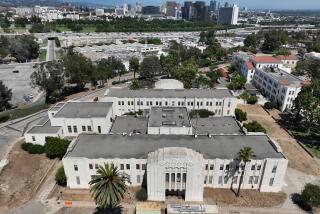The Fight Over the Ambassador
- Share via
Sometimes, Mayor Tom Bradley just hates a good fight.
An example of that is the battle between the school board and city government over the future of the old Ambassador Hotel site. It’s a fight that is threatening to delay the construction of a badly needed high school in central Los Angeles and the revival of a fading but important commercial and residential area, the Mid-Wilshire District.
Remember last January when Donald Trump and wife Ivana--this was just before the Big Split--swept into the Ambassador? As Ivana watched, Trump announced plans for a huge office, retail, hotel development on the 23-acre site of the defunct Ambassador, including the world’s tallest building--125 floors or more.
Bradley, at Trump’s side, welcomed him to town, although he said he didn’t especially approve of the size of the office tower. But Trump’s building plan was so wild that several politicians opposed the idea.
Trump, however, wasn’t the issue. Long before Trump bought a share of the Ambassador acreage, politically influential Mid-Wilshire property owners had been after Bradley to help them save the once-glamorous area. With the city short of planning funds, the property owners hired Urban Innovations Group, a planning organization run by architects, planners and students from UCLA’s Graduate School of Architecture and Urban Planning.
Urban Innovations and the school’s Dean Richard Weinstein came up with a plan for a high-rise, commercial Mid-Wilshire, with the Ambassador property a centerpiece featuring retail stores, a hotel, residences and office buildings.
It was imaginative. Strict city controls would assure continuation of low- and moderate-rent apartment housing south of Wilshire. The new buildings would provide jobs for the thousands of families in the area. And completion of the Metro Rail subway would tie Mid-Wilshire to downtown, and more jobs.
Most important--and this must be remembered--Bradley and the City Council supported the UCLA planners’ proposal.
The Los Angeles Unified School District had another idea.
The district had been looking for a site for a new high school to relieve overcrowding at Belmont, Los Angeles and Manual Arts high schools. When the Ambassador folded, the district decided to buy the site, using its power to condemn land if necessary.
The land is expensive. In fact, today the school board is asking the State Allocations Board in Sacramento for $120 million for the purchase--$30 million less than what Trump said the land is worth.
With public money scarce, the school district proposed a new financing approach, a partnership with a private developer to build department stores, a shopping mall and a 30-story office tower and residential units on the portion of the property fronting Wilshire Boulevard. Money for rents and leases would pay for the school, which would be toward the back.
By this time, the issue had become politically hot. Old Bradley foe Councilman Zev Yaroslavsky blasted the Trump development. So did powerful Assemblywoman Maxine Waters, a Los Angeles Democrat who’s gone against the mayor before. Joining her was her political ally, Los Angeles Democratic Assemblyman Mike Roos, who represents the area and would like to run for mayor. Politically smart school board President Jackie Goldberg organized neighborhood group opposition to Trump’s plan.
As the controversy became more heated, Bradley faded from the scene. The UCLA planners’ bright idea was left without support, except from the Trump organization, more of a millstone than a help.
It’s too bad. The UCLA group makes a convincing point that it’s insanity to build a shopping mall next to a high school. Teen-agers are great, but they’re not conducive to an afternoon of shopping at Nordstrom or a quiet drink at the bar downstairs from the office. Nor would many people choose to live next door to a high school.
Mark Fabiani, Bradley’s chief of staff, said the mayor continues to agree with the planners that a school shouldn’t be built at the Ambassador site.
Unfortunately, he isn’t active in face-to-face negotiations with the school board. Fabiani said the mayor is working behind the scenes.
Bradley is pressing Trump to put up money for replacement housing if the school board shifts the high school to a residential neighborhood and allows the developer to have the entire Ambassador site.
But that’s not the issue. The school board refuses to abandon its Ambassador dream, so Bradley will need to find another school site and persuade the board to accept it. That’s the only way he will be able to back up his planners and save the Mid-Wilshire revival plan.
More to Read
Sign up for Essential California
The most important California stories and recommendations in your inbox every morning.
You may occasionally receive promotional content from the Los Angeles Times.













